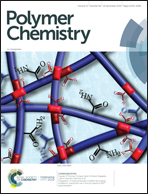Control over chiroptical and electronic properties of poly(9,9′-bifluorenylidene) bearing chiral side chains†
Abstract
9,9′-Bifluorenylidene (9,9′-BF) is a twisted π-conjugated molecule, whose nonplanar molecular geometry endows it with inherent axial chirality. However, 9,9′-BF undergoes rapid plus (P) and minus (M) racemization due to the low barrier for such equilibrium. In this study, we demonstrate that the introduction of chiral side chains at peripheral positions of the 9,9′-BF moiety can bias its dynamic molecular helicity efficiently, giving rise to diastereoisomer-enriched 9,9′-BF monomers. Compared with achiral polymers prepared from achiral 9,9′-BF monomers, the chirally twisted monomers lead to chiral polymers adopted P or M helicity. The intermolecular interaction of these polymers allows the formation of chiral aggregates as higher ordered structures. A series of random copolymers consisting of chiral and achiral 9,9′-BF units are synthesized via Yamamoto polycondensation, which allows us to investigate the effect of structural perturbation on chiroptical and electronic properties of analogous polymers. The chiral orientation of polymers was maintained in the solid state. The modulation of HOMO energy levels by gradual insertion of chiral monomers into achiral polymer backbones was nicely achieved.



 Please wait while we load your content...
Please wait while we load your content...